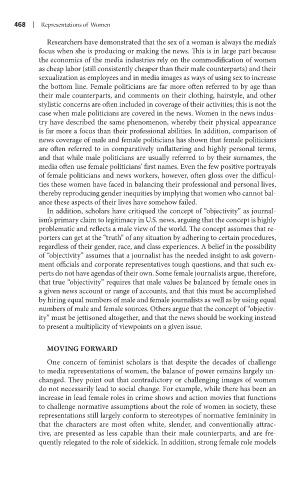Page 489 - Battleground The Media Volume 1 and 2
P. 489
| Representat ons of Women
Researchers have demonstrated that the sex of a woman is always the media’s
focus when she is producing or making the news. This is in large part because
the economics of the media industries rely on the commodification of women
as cheap labor (still consistently cheaper than their male counterparts) and their
sexualization as employees and in media images as ways of using sex to increase
the bottom line. Female politicians are far more often referred to by age than
their male counterparts, and comments on their clothing, hairstyle, and other
stylistic concerns are often included in coverage of their activities; this is not the
case when male politicians are covered in the news. Women in the news indus-
try have described the same phenomenon, whereby their physical appearance
is far more a focus than their professional abilities. In addition, comparison of
news coverage of male and female politicians has shown that female politicians
are often referred to in comparatively unflattering and highly personal terms,
and that while male politicians are usually referred to by their surnames, the
media often use female politicians’ first names. Even the few positive portrayals
of female politicians and news workers, however, often gloss over the difficul-
ties these women have faced in balancing their professional and personal lives,
thereby reproducing gender inequities by implying that women who cannot bal-
ance these aspects of their lives have somehow failed.
In addition, scholars have critiqued the concept of “objectivity” as journal-
ism’s primary claim to legitimacy in U.S. news, arguing that the concept is highly
problematic and reflects a male view of the world. The concept assumes that re-
porters can get at the “truth” of any situation by adhering to certain procedures,
regardless of their gender, race, and class experiences. A belief in the possibility
of “objectivity” assumes that a journalist has the needed insight to ask govern-
ment officials and corporate representatives tough questions, and that such ex-
perts do not have agendas of their own. Some female journalists argue, therefore,
that true “objectivity” requires that male values be balanced by female ones in
a given news account or range of accounts, and that this must be accomplished
by hiring equal numbers of male and female journalists as well as by using equal
numbers of male and female sources. Others argue that the concept of “objectiv-
ity” must be jettisoned altogether, and that the news should be working instead
to present a multiplicity of viewpoints on a given issue.
moving ForwarD
One concern of feminist scholars is that despite the decades of challenge
to media representations of women, the balance of power remains largely un-
changed. They point out that contradictory or challenging images of women
do not necessarily lead to social change. For example, while there has been an
increase in lead female roles in crime shows and action movies that functions
to challenge normative assumptions about the role of women in society, these
representations still largely conform to stereotypes of normative femininity in
that the characters are most often white, slender, and conventionally attrac-
tive, are presented as less capable than their male counterparts, and are fre-
quently relegated to the role of sidekick. In addition, strong female role models

